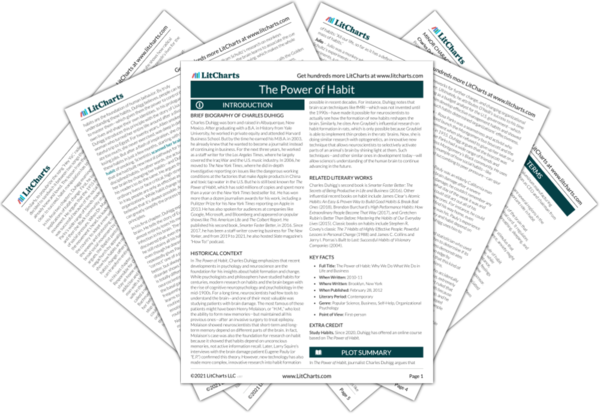Paul O'Neill Quotes in The Power of Habit
Where should a would-be habit master start? Understanding keystone habits holds the answer to that question: The habits that matter most are the ones that, when they start to shift, dislodge and remake other patterns.

Unlock explanations and citation info for this and every other The Power of Habit quote.
Plus so much more...
Get LitCharts A+What most people didn’t realize, however, was that O’Neill’s plan for getting to zero injuries entailed the most radical realignment in Alcoa’s history. The key to protecting Alcoa employees, O’Neill believed, was understanding why injuries happened in the first place. And to understand why injuries happened, you had to study how the manufacturing process was going wrong. To understand how things were going wrong, you had to bring in people who could educate workers about quality control and the most efficient work processes, so that it would be easier to do everything right, since correct work is also safer work.
In other words, to protect workers, Alcoa needed to become the best, most streamlined aluminum company on earth.
O’Neill’s experiences with infant mortality illustrate the second way that keystone habits encourage change: by creating structures that help other habits to flourish. In the case of premature deaths, changing collegiate curriculums for teachers started a chain reaction that eventually trickled down to how girls were educated in rural areas, and whether they were sufficiently nourished when they became pregnant. And O’Neill’s habit of constantly pushing other bureaucrats to continue researching until they found a problem’s root causes overhauled how the government thought about problems like infant mortality.

Paul O'Neill Quotes in The Power of Habit
Where should a would-be habit master start? Understanding keystone habits holds the answer to that question: The habits that matter most are the ones that, when they start to shift, dislodge and remake other patterns.

Unlock explanations and citation info for this and every other The Power of Habit quote.
Plus so much more...
Get LitCharts A+What most people didn’t realize, however, was that O’Neill’s plan for getting to zero injuries entailed the most radical realignment in Alcoa’s history. The key to protecting Alcoa employees, O’Neill believed, was understanding why injuries happened in the first place. And to understand why injuries happened, you had to study how the manufacturing process was going wrong. To understand how things were going wrong, you had to bring in people who could educate workers about quality control and the most efficient work processes, so that it would be easier to do everything right, since correct work is also safer work.
In other words, to protect workers, Alcoa needed to become the best, most streamlined aluminum company on earth.
O’Neill’s experiences with infant mortality illustrate the second way that keystone habits encourage change: by creating structures that help other habits to flourish. In the case of premature deaths, changing collegiate curriculums for teachers started a chain reaction that eventually trickled down to how girls were educated in rural areas, and whether they were sufficiently nourished when they became pregnant. And O’Neill’s habit of constantly pushing other bureaucrats to continue researching until they found a problem’s root causes overhauled how the government thought about problems like infant mortality.











